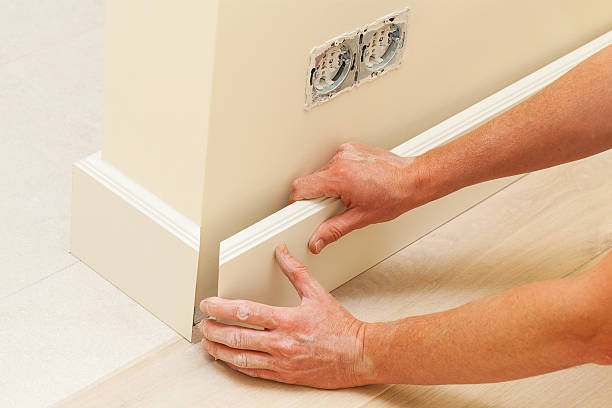Installing baseboards is a small but crucial aspect of home improvement projects. Whether renovating your home or building a new one, understanding the intricacies of baseboard installation can significantly improve the room’s appearance and function.
This comprehensive guide explores seven essential factors to consider during baseboard installation; covering costs, hiring contractors, and expert tips to ensure a flawless finish.
Let’s get started.
Key Considerations for Baseboard Installation
Before you begin any baseboard installation in your home, it is a good idea to understand these various aspects to make informed choices.

- Selecting the Right Baseboard Materials
When selecting baseboard materials, it is essential to consider how they look and function. Wooden baseboards offer a classic and elegant look; this makes them a popular choice for traditional home designs. However, they may require more maintenance than other materials.
MDF (Medium Density Fiberboard) baseboards are a more affordable option that mimics the appearance of wood but is more resistant to moisture and warping. PVC (polyvinyl chloride) and vinyl baseboards are highly durable, easy to clean, and ideal for high-traffic areas such as kitchens and bathrooms.
Expert Tip: When choosing baseboard materials, prioritize their durability and ease of maintenance, especially in areas prone to moisture or heavy foot traffic. Consider the overall aesthetic of your space and opt for materials that complement your interior design.
- Measuring and Planning
Accurate measurements are the cornerstone of successful baseboard installation. Before purchasing materials or hiring contractors, measure each wall precisely. This includes accounting for corners, doorways, and other architectural features.
Adding a slight buffer to your measurements is advisable to accommodate potential errors or irregularities in the walls. Once you have accurate measurements, plan the layout of your baseboards. Consider the baseboard height, room height, and visual symmetry.
Expert Tip: Invest in a quality tape measure and double-check your measurements before making any final decisions or purchases to avoid costly installation mistakes.
- Preparation of the Installation Area
Proper preparation of the installation area is crucial for achieving professional-looking results. Start by removing any existing baseboards and thoroughly cleaning the walls to remove dust, dirt, and debris. Inspect the walls for any signs of damage, such as cracks or holes, and repair them using a spackling or joint compound. Sand down rough patches and ensure the surface is smooth and free of imperfections before proceeding with the installation.
Expert Tip: Take the time to properly prep the installation area to ensure a seamless and long-lasting finish. Proper surface preparation improves the appearance of your baseboards and enhances their durability and longevity.
- Understanding Baseboard Installation Techniques
Baseboard installation techniques vary depending on factors such as the baseboard material type and the walls’ condition. The most common installation methods include nail-down, glue-down, and floating installations. Nail-down installation involves securing the baseboards to the wall using brad nails or finishing nails. Glue-down installation uses adhesive to bond the baseboards directly to the wall while floating installations involve attaching the baseboards to a separate base or track system. Before installation, check out different moulding and baseboard styles.
Expert Tip: Consider the condition of your walls and the type of baseboard material when selecting an installation technique. Consult a professional baseboard contractor to determine the most suitable method for your project.
- Calculating Baseboard Installation Costs
Estimating the cost of baseboard installation involves various factors, including material expenses, labour costs, and additional supplies. Baseboards cost between $2 and $6 per linear square foot. The price difference varies greatly depending on the width, style, and type of baseboard. Most baseboard renovations cost between $350 and $575 to install.
To get an accurate estimate, request quotes from multiple contractors and compare prices based on the scope of work and materials used.
Expert Tip: When budgeting for baseboard installation, factor in additional costs such as caulking, paint, and trim accessories. Be sure to communicate your budget constraints with your contractor to ensure transparency and avoid any unexpected expenses.
- Hiring Qualified Baseboard Contractors
Choosing the right contractor is essential for achieving professional results and a stress-free installation experience. Research local contractors and read reviews from previous clients. Ask friends, family, and colleagues who have recently completed similar home improvement projects for their recommendations.
When evaluating potential contractors, consider their experience, credentials, and customer satisfaction ratings. You should also request references and portfolios of past projects to assess their workmanship and attention to detail.
Expert Tip: Don’t hesitate to ask questions and request detailed quotes from prospective contractors. A reputable contractor will be transparent about their pricing, timeline, and any potential challenges associated with your project. Trust your instincts and choose a contractor who communicates effectively and demonstrates a commitment to customer satisfaction.
- Maintaining Baseboards for Longevity
Proper maintenance is one key to preserving the appearance and functionality of your baseboards. Incorporate regular cleaning and inspection routines into your home maintenance schedule to prevent dirt buildup and identify any signs of damage or wear.
Use a soft cloth or sponge dampened with mild soap and water to clean baseboards regularly; avoid harsh chemicals or abrasive cleaning tools that may damage the finish. Inspect baseboards periodically for cracks, chips, or gaps and address any issues promptly to prevent further damage or deterioration.
Expert Tip: Consider applying a protective finish or sealant to your baseboards to enhance their durability and resistance to moisture and stains. Follow manufacturer recommendations for cleaning and maintenance to prolong their lifespan and keep them looking new for years.
Baseboard installation is a significant investment that can enhance your home’s aesthetics and functionality. Consider factors such as materials, costs, contractors, and maintenance to ensure a successful and visually appealing installation. Whether tackling the project yourself or hiring a professional contractor, careful planning, preparation, and attention to detail are essential for achieving optimal results. With the information in this guide, you are well-equipped to embark on your baseboard installation journey with confidence.
